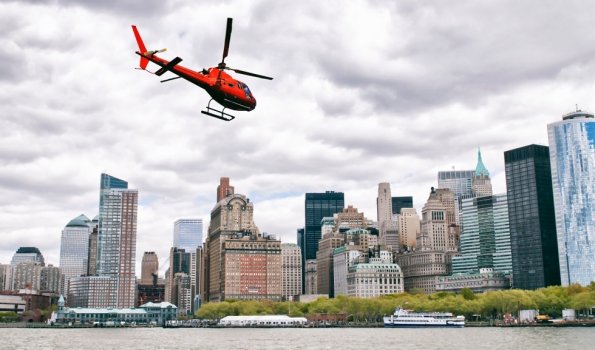K
Kathleen Martin
Guest
In 2018, aerospace engineer Daniel Cuppoletti went to a conference in Los Angeles about the future of metropolitan air transportation. He arrived skeptical about the mere intent of the summit, which was run by ride-hailing company Uber.
But by the time he left, Cuppoletti saw the world in a whole new light. "I suddenly thought: there's a vision here, and it's real. It's not replacing commercial aircraft transportation, it's creating an entirely new market for something that we don't have at this moment," he said.
That new market was for short flights in piloted air taxis (sometimes known as eVTOLs) and drones to deliver medicines and other supplies. Yes, there would be issues around how urban air space is used, but Cuppoletti also saw a specific problem, one that he was uniquely poised to address as someone who studied aeroacoustics: the noise that these vehicles would make when they flew.
He began researching this issue with colleagues at the University of Cincinnati. There is one particularly thorny problem: when propellers whoosh and whir, even when they're connected to electric engines, they produce a lot of sound. The European Union Aviation Safety Agency has recently reported safety, security and noise as the top three concerns for drones. Cuppoletti and his students presented their work at the Science and Technology Forum and Exposition last month in San Diego.
Thousands of noise complaints are lodged to the Federal Aviation Administration each year. The problem is especially pronounced in lower-income areas. Drones don't have the same jet engines as larger aircraft, but their systems still buzz and whir. And while the United States sees about 5,700 commercial aircraft flights each day, drones and eVTOLs could soon add thousands of daily flights in major metropolitan areas.
Think of the noise of one helicopter over your house, Cuppoletti said. Now multiply that: "Imagine having 1,000 helicopters fly over [in] one day -- they're going to get regulated out of existence."
Cuppoletti's research focuses on modeling the sound that comes out of turbines and finding ways to reduce that noise, using strategies such as changing the configurations of rotors, shielding them in tubes, and adding other tweaks. His lab uses an anechoic chamber, covered on all sides by sound-dampening material and outfitted with a suite of eight microphones, to test the frequency, wavelength and amplitude of sound. The models he and his students are creating will eventually be part of a guidebook that manufacturers of drones and flying cars can use to anticipate what their novel designs will sound like.
One way to reduce the unwanted impacts of these vehicles is to route them over roads, which are already noisy, said Antonio Torija Martinez, who studies the impact of drone noises on communities at the University of Salford in Manchester, England.
Continue reading: http://www.insidescience.org/news/drowning-out-sound-drones
But by the time he left, Cuppoletti saw the world in a whole new light. "I suddenly thought: there's a vision here, and it's real. It's not replacing commercial aircraft transportation, it's creating an entirely new market for something that we don't have at this moment," he said.
That new market was for short flights in piloted air taxis (sometimes known as eVTOLs) and drones to deliver medicines and other supplies. Yes, there would be issues around how urban air space is used, but Cuppoletti also saw a specific problem, one that he was uniquely poised to address as someone who studied aeroacoustics: the noise that these vehicles would make when they flew.
He began researching this issue with colleagues at the University of Cincinnati. There is one particularly thorny problem: when propellers whoosh and whir, even when they're connected to electric engines, they produce a lot of sound. The European Union Aviation Safety Agency has recently reported safety, security and noise as the top three concerns for drones. Cuppoletti and his students presented their work at the Science and Technology Forum and Exposition last month in San Diego.
Thousands of noise complaints are lodged to the Federal Aviation Administration each year. The problem is especially pronounced in lower-income areas. Drones don't have the same jet engines as larger aircraft, but their systems still buzz and whir. And while the United States sees about 5,700 commercial aircraft flights each day, drones and eVTOLs could soon add thousands of daily flights in major metropolitan areas.
Think of the noise of one helicopter over your house, Cuppoletti said. Now multiply that: "Imagine having 1,000 helicopters fly over [in] one day -- they're going to get regulated out of existence."
Cuppoletti's research focuses on modeling the sound that comes out of turbines and finding ways to reduce that noise, using strategies such as changing the configurations of rotors, shielding them in tubes, and adding other tweaks. His lab uses an anechoic chamber, covered on all sides by sound-dampening material and outfitted with a suite of eight microphones, to test the frequency, wavelength and amplitude of sound. The models he and his students are creating will eventually be part of a guidebook that manufacturers of drones and flying cars can use to anticipate what their novel designs will sound like.
One way to reduce the unwanted impacts of these vehicles is to route them over roads, which are already noisy, said Antonio Torija Martinez, who studies the impact of drone noises on communities at the University of Salford in Manchester, England.
Continue reading: http://www.insidescience.org/news/drowning-out-sound-drones

